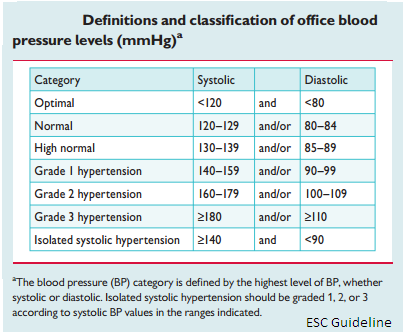Overall, the prevalence of hypertension appears to be around 30–45% of the general population, with a steep increase with ageing.
Overall, the prevalence of hypertension appears to be around 30–45% of the general population, with a steep increase with ageing. There also appear to be noticeable differences in the average BP levels across countries, with no systematic trends towards BP changes in the past decade. A close relationship between prevalence of hypertension and mortality for stroke has been reported. The incidence and trends of stroke mortality in Europe have been analysed by use of World Health Organization (WHO) statistics. Western European countries exhibit a downward trend, in contrast to eastern European countries, which show a clear-cut increase in death rates from stroke.
 |
-The continuous relationship between Blood Pressure and Cardiovacular and renal events makes the distinction between normotension and hypertension difficult when based on cut-off BP values. In practice, however, cut-off BP values are universally used, both to simplify the diagnostic approach and to facilitate the decision about treatment. Estimation of total CV risk is easy in particular subgroups of patients, such as those with antecedents of established cardiovascular disease (CVD), diabetes, CHD or with severely elevated single risk factors. In all of these conditions, the total CV risk is high or very high, calling for intensive CV risk-reducing measures |
The Systematic COronary Risk Evaluation (SCORE) model has been developed based on large European cohort studies. The model estimates the risk of dying from CV (not just coronary) disease over 10 years based on age, gender, smoking habits, total cholesterol and SBP. The SCORE model allows calibration of the charts for individual countries, which has been done for numerous European countries. At the international level, two sets of charts are provided: one for high-risk and one for low-risk countries.The electronic, interactive version of SCORE, known as HeartScore (available through www.heartscore.org), is adapted to also allow adjustment for the impact of high-density lipoprotein cholesterol on total CV risk.
The initial evaluation of a patient with hypertension should
(i)confirm the diagnosis of hypertension.
(ii) detect causes of secondary hypertension
(iii) assess CV risk, OD and concomitant clinical conditions.
This calls for BP measurement, medical history including family history, physical examination, laboratory investigations and further diagnostic tests. Some of the investigations are needed in all patients; others only in specific patient groups.
|
-Measurement of BP at the upper arm is preferred and cuff and bladder dimensions should be adapted to the arm circumference. -In elderly subjects, diabetic patients and in other conditions in which orthostatic hypotension may be frequent or suspected, it is recommended that BP be measured 1 min and 3 min after assumption of the standing position. Orthostatic hypotension—defined as a reduction in SBP of ≥20 mmHg or in DBP of ≥10 mmHg within 3 min of standing—has been shown to carry a worse prognosis for mortality and CV events. -BP measurements should always be associated with measurement of heart rate, because resting heart rate values independently predict CV morbid or fatal events in several conditions, including hypertension. |
 |
ESC Guideline
Duc Tin Clinic
Tin tức liên quan

Performance diagnostique de l’interféron gamma dans l’identification de l’origine tuberculeuse des pleurésies exsudatives

A Mixed Phenotype of Airway Wall Thickening and Emphysema Is Associated with Dyspnea and Hospitalization for Chronic Obstructive Pulmonary Disease.

Radiological Approach to Asthma and COPD-The Role of Computed Tomography.

Significant annual cost savings found with UrgoStart in UK and Germany

Thrombolex announces 510(k) clearance of Bashir catheter systems for thromboembolic disorders
Phone: (028) 3981 2678
Mobile: 0903 839 878 - 0909 384 389







